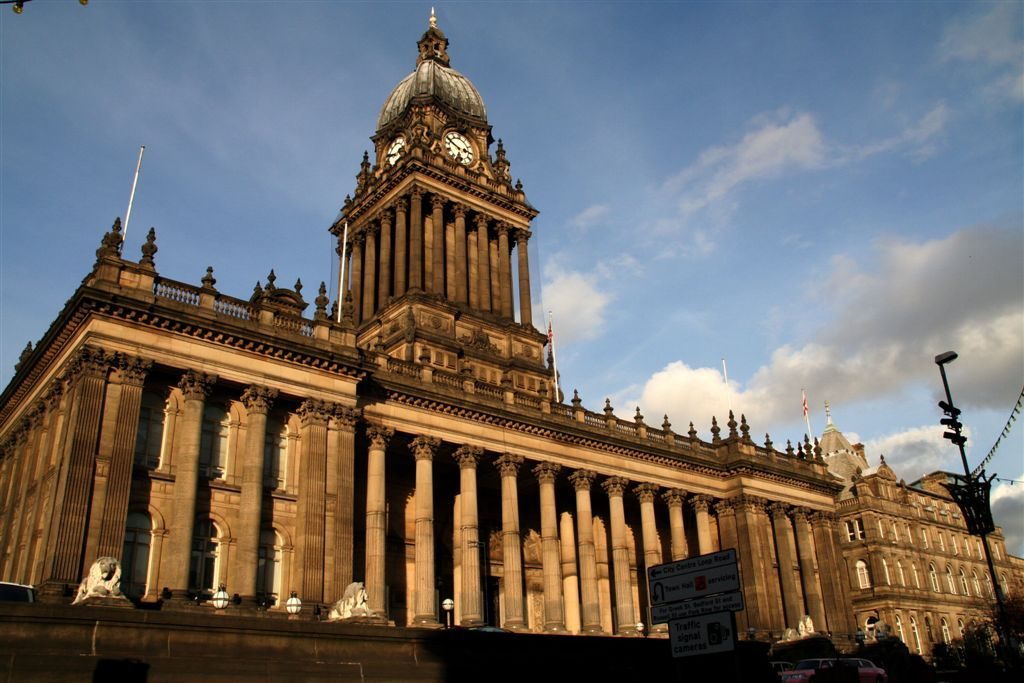Leeds Town Hall. You probably walk past it almost every day. Chris Nickson tells us more about one of our most iconic buildings.
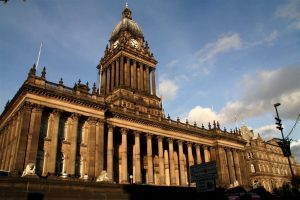 You know it. Almost anyone who’s visited Leeds or seen a picture of the city knows it. The Town Hall, our homage to Victorian stability, grandeur, and wealth. It’s a building utterly identified with Leeds. Yet in spite of its stern 19th century style and sense of timeless solidity, it’s just been one in a series of administrative centres in Leeds, and its glory days were quite short – only about 70 years until the running of the city moved elsewhere.
You know it. Almost anyone who’s visited Leeds or seen a picture of the city knows it. The Town Hall, our homage to Victorian stability, grandeur, and wealth. It’s a building utterly identified with Leeds. Yet in spite of its stern 19th century style and sense of timeless solidity, it’s just been one in a series of administrative centres in Leeds, and its glory days were quite short – only about 70 years until the running of the city moved elsewhere.
Go back more than a thousand years, when Leeds was no more than a tiny Norman manor, or even earlier, and everything was handled from the manor court which stood over the communal oven at the bottom of Kirkgate, next to the Parish Church. It stayed in the same spot for several centuries, our Moot Hall, where people met and made their decisions for the village, and where the local courts were held. It’s a reminder that Leeds was still a village then, even if it had started on the road to prosperity with woollen cloth.
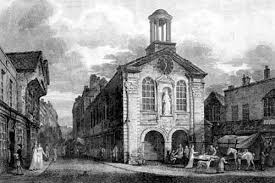 By the beginning of the 1600s, though, Leeds was growing, and required a building that better served its needs. By 1620 the first Moot Hall had been built, smack in the middle of Briggate – still one of the questions that should make anyone wonder why – close to where Harvey Nichols now stands. However, the business of Leeds was only conducted upstairs. The ground floor consisted of shops, and on either side of the street stood the Shambles, with all the butchers’ shops, and the slaughtering of animals. The stocks stood in front, and on one occasion the heads of traitors (those found guilty in the Farnley Wood plot) were displayed on stakes.
By the beginning of the 1600s, though, Leeds was growing, and required a building that better served its needs. By 1620 the first Moot Hall had been built, smack in the middle of Briggate – still one of the questions that should make anyone wonder why – close to where Harvey Nichols now stands. However, the business of Leeds was only conducted upstairs. The ground floor consisted of shops, and on either side of the street stood the Shambles, with all the butchers’ shops, and the slaughtering of animals. The stocks stood in front, and on one occasion the heads of traitors (those found guilty in the Farnley Wood plot) were displayed on stakes.
By 1710 it was apparent that the building needed to be replaced. And it was. In exactly the same spot. The new structure had a statue of Queen Anne above the door, which can now be seen at Leeds Art Gallery, and the butchers had taken over the ground floor. A series of shops and tradesmans’ workshops, known as Middle Row, stood behind, trailing up Briggate, towards the new Market Cross at the top of the street.
That was how things remained for more than 100 years, during which time Leeds grew rapidly. It had become wealthy and powerful from the wool trade, and when the Industrial Revolution began in the late 1700s, it was ideally placed for the new manufactories that were being built.
By the beginning of the 19th century, it was obvious that Leeds needed somewhere larger, and grander, in order for the town’s administration to function properly. So, in 1825, the Moot Hall and Middle Row were demolished, and the site immediately became home to the Corn Exchange, before it moved to the location everyone knows.
But Leeds had no Moot Hall, no Town Hall.
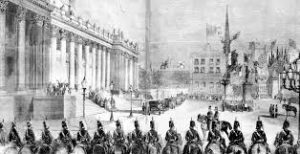 We’d have to wait over 30 years for that. It took several years of planning and a winning design by architect Cuthbert Broderick, then just 29 years old. And costs that were almost four times the original budget. But in 1858 the new Town Hall was opened by Queen Victoria herself, the only time she visited Leeds. Thousands upon thousands turned out to greet her and see her open this new palace of wonders, a building fit for one of the Towns of Empire (not a city until 1893, though).
We’d have to wait over 30 years for that. It took several years of planning and a winning design by architect Cuthbert Broderick, then just 29 years old. And costs that were almost four times the original budget. But in 1858 the new Town Hall was opened by Queen Victoria herself, the only time she visited Leeds. Thousands upon thousands turned out to greet her and see her open this new palace of wonders, a building fit for one of the Towns of Empire (not a city until 1893, though).
It had everything: a grand hall for concerts, plenty of offices, even a bridewell for locking up criminals. It fitted the time and their spirit. The epic scale of it demonstrated the sense of pride people had in Leeds.
But the times, they were a-changin’, and by 1930, what Leeds required had outgrown all the possibilities of the Town Hall. More room for different departments and their clerks. That led to the building of the Civic Hall. That, too, was opened by royalty, Victoria’s grandson, George V, in 1933.
Yet we still think of the Town Hall as the functioning heart of the city. You can hear concerts in the Victoria Hall, get married in the building, take a tour that goes from basement to clock tower. It’s become embedded in our consciousness as the symbol of Leeds, immediately recognisable – from the tatty white lions guarding the steps in front who suspend time and shift positions when the clock strikes 13, according to legend. In Leeds poet Ian Harker’s The Lions of Leeds Town Hall he has them “…come up Park Row/claws clack-clacking on flags/leaping over parked cars, nosing in litter bins.” – to the clock that’s visible even as you walk up the Headrow from Eastgate.
It’s curious, perhaps, that in a city with such a large working-class population, a place that so obviously shouts solidity and wealth has become the idea of who we are. Yet some things defy reason. Churchill stood on its steps to address crowds in World War II. Don Revie and Leeds United paraded their trophies there. It’s a building that encompasses us all, one that’s bigger than all of us. And in that way, it will never outgrow its usefulness to Leeds.
Chris Nickson is the author of several historical crime novels set in Leeds. The Tin God is the long awaited sixth novel in the Tom Harper series. The Tin God is published on Friday and can be pre-ordered here.
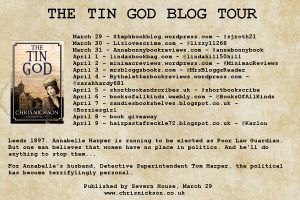 If you want to find out more about Chris and the background to the Tin God, he’s on tour – a blog tour!
If you want to find out more about Chris and the background to the Tin God, he’s on tour – a blog tour!
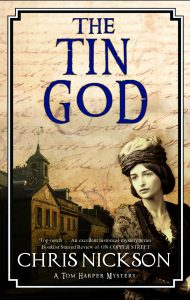 Leeds, England. October, 1897. Superintendent Harper is proud of his wife Annabelle. She’s one of seven women selected to stand for election as a Poor Law Guardian. But even as the campaign begins, Annabelle and the other female candidates start to receive anonymous letters from someone who believes a woman’s place lies firmly in the home.
Leeds, England. October, 1897. Superintendent Harper is proud of his wife Annabelle. She’s one of seven women selected to stand for election as a Poor Law Guardian. But even as the campaign begins, Annabelle and the other female candidates start to receive anonymous letters from someone who believes a woman’s place lies firmly in the home.
The threats escalate into outright violence when an explosion rips through the church hall where Annabelle is due to hold a meeting – with fatal consequences. The only piece of evidence Harper has is a scrap of paper left at the scene containing a fragment from an old folk song. But what is its significance?
As polling day approaches and the attacks increase in menace and intensity, Harper knows he’s in a race against time to uncover the culprit before more deaths follow. With the lives of his wife and daughter at risk, the political becomes cruelly personal.
The Tin God will be launched at a free event at 1pm on 5 May at Leeds Central Library as part of The Vote Before The Vote exhibition in Room 700, Central Library, Leeds.

